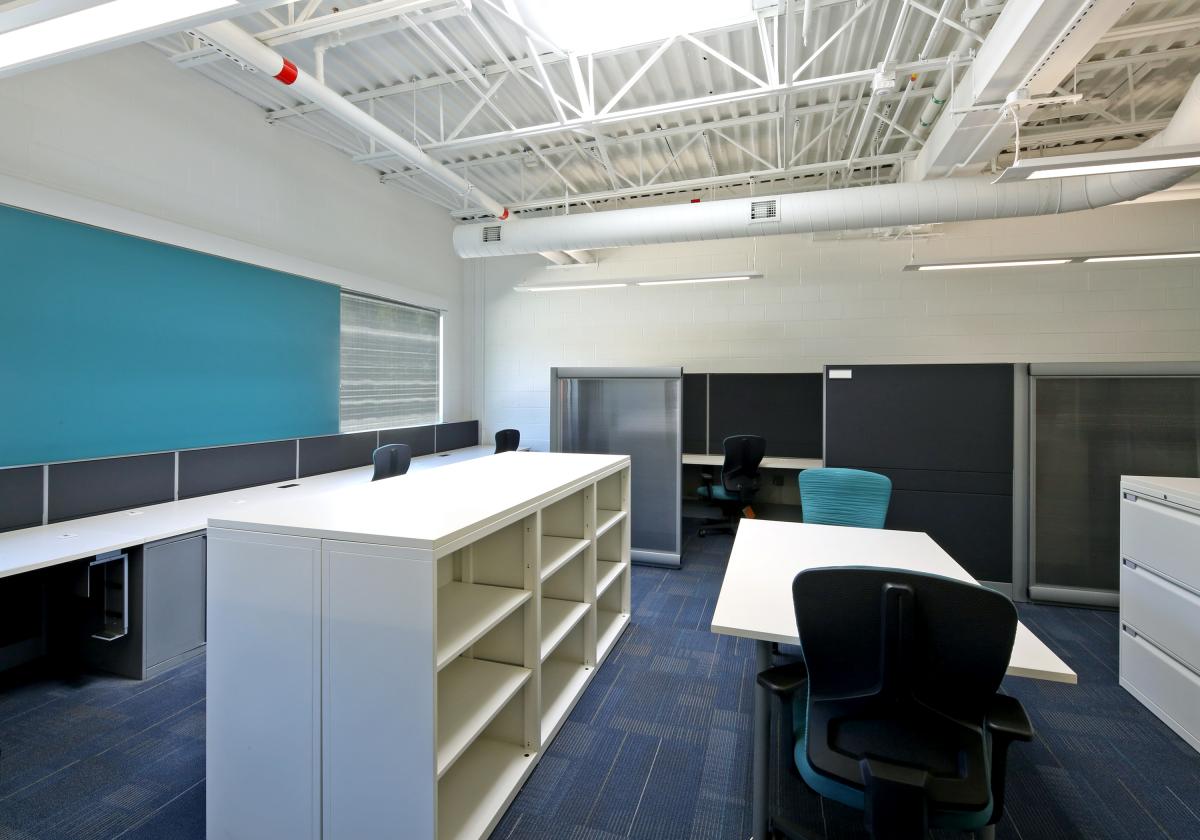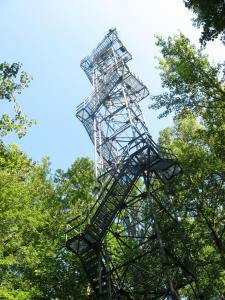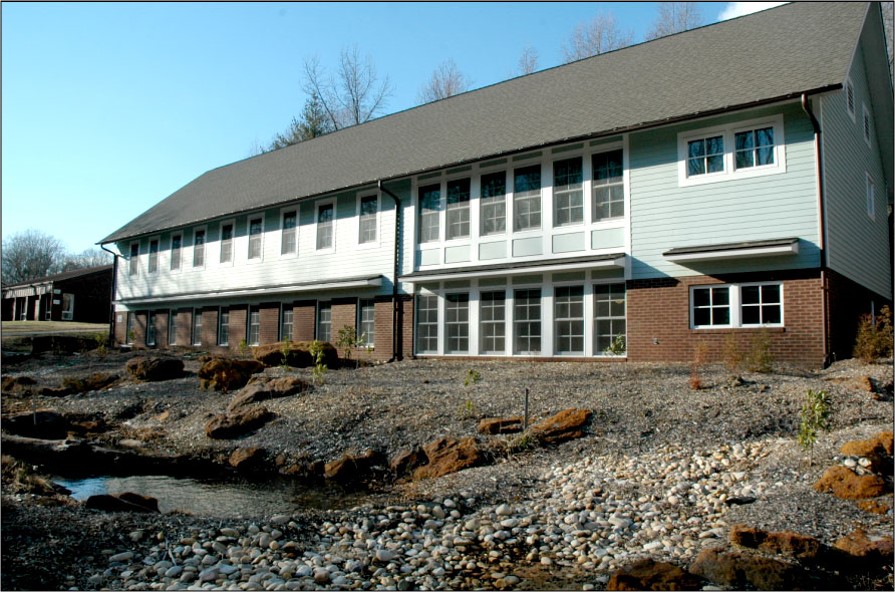General Information:
The Smithsonian Environmental Research Center (SERC) offers a variety of research, office and conference facilities. Our 92,000 ft2 LEED-Platinum Charles McC. Mathias building consists of 69,000 ft2 of office and laboratory space with on-site solar energy production, geothermal heating and cooling, water reclamation system and stormwater management wetlands.
We offer guest Wi-Fi and Eduroam in all campus buildings. Please click on the accordion tabs below for details about each facility. For questions about housing and meeting spaces, contact SERCreservations@si.edu.
Research Facilities:
Mathias Laboratory

The Charles McC. Mathias Laboratory houses 92,000 ft2 of laboratory and office space. The building houses a field prep and storage area, wet and dry sample storage, chemical sample prep area, shop area and environmental control rooms. Lab spaces are open concept with computer stations, adjustable lab benches, snorkel-style bench hoods, chemical fume hoods and DI water system.

We have a variety of office spaces outfitted with new work stations, furniture and storage. Many of our lab areas contain additional work stations overlooking our management wetlands.
GCREW Research Wetland

The Global Change Research Wetland (GCREW) is a National Science Foundation-Long Term Research in Environmental Biology facility dedicated to unraveling the complex ecological processes that confer stability on coastal marshes as they respond to global environmental change. If you would like more information about GCREW, please contact Dr. Pat Megonigal.
GCREW:
- Supports four long-term global change experiments, marsh-wide observations of plant community composition and productivity, import-export budgets for dissolved, particulate and gaseous forms of carbon, and detailed surface elevation observations
- Is a sentinel site used by NOAA, NASA, NSF, DOE and the Smithsonian Marine Global Earth Observatory Network to build and validate spatial data on carbon stocks, elevation change and other fundamental tidal wetland data
- Conduct forward-looking experiments on the impacts of carbon dioxide, temperature, and nitrogen at levels projected into the next century. The data are used to model and forecast changes in tidal wetland ecosystem ecology
- Welcomes collaborators from across the world, offers professional training to postdocs, graduate students, and interns, and engages the public in Participatory Science
GIS Laboratory
SERC’s GIS Laboratory is run by our Ecological Modeling Laboratory and has access to a broad range of capabilities in ecological modeling and spatial analysis for your GIS needs.
- Software licenses: ESRI ArcGIS, ENVI, ERDAS, and various third-party add-ons for these major packages
- Programming languages: Absoft FORTRAN and C compliers and Microsoft’s Visual Studio.net, including VisualBasic, C+, C#, and J#
- Statistical and graphics: R, SAS, DataDesk, Amos and SigmaPlot
- Small and large format printers are available for printing maps and model results
Meteorological Tower

We have a 120 ft meteorological tower which provides a stable platform and unobstructed sky view for a variety of research needs including SERC’s long-term environmental monitoring.
Meteorological Data Collection Includes:
- Temperature, relative humidity, wind speed and rainfall
- Solar and spectral ultraviolet radiation
- Precipitation data monitoring rainfall chemistry and mercury deposition
- Other instrumentation from NASA

The platform has AC power and network access. Limited space is available for deployment of other instrumentation. For more information about the meteorological tower, please contact Dr. Pat Neale.
Research Wetlab

Our 1150 ft2 wetlab and outdoor research area is located on the Rhode River with easy access to our private dock and the Chesapeake Bay. Wetlab and outdoor research area amenities include:
- Central heating and air
- Ambient unfiltered flow-through water system
- Compressed air lines
- Rectangular fiberglass tanks (300 gal)
- Round fiberglass tanks
- 6 ft diam. (650 gal)
- 4 ft diam. (300 gal)
- Outdoor concrete pad for research tanks (flexible configuration)
- Wi-Fi, computer and printer access
Research Vehicle and Boat Fleet

The Smithsonian Environmental Research Center has a variety of research vehicles and boats available for research and education trips.
Research Vehicles:
- 4 x 4 trucks with towing/trailering capacity
- Trucks with and without caps
- Trucks seat up to 4 passengers
- Vans seat up to 6 passengers
- Gas, deisel, hybrid options
SERC has a fleet of research vessels and small open boats for research and education programs on the Chesapeake Bay and its tributaries. Since SERC is located on the Rhode River, our private research dock provides easy access to the river and the mainstem of the Chesapeake Bay. Please contact Sam Benson for information about chartering the R/V SERC or other research vessels.
R/V SERC:
- LOA: 41 Feet
- Beam: 14 Feet
- Draft: 4 Feet
- Hull Material: Aluminum
- Cruising Speed: 18 Knots
- Crew: 2
- Scientists: 14
- Propulsion: Twin Cummins 503M Turbo diesels
- Electrical: Portable 1kw Honda generator, 50 amp shore power
- Navigation: Furuno GP 1850WD Color DGPS Plotter, Furuno 1731 MK3 Radar, Furuno FCV 620 Echo Sounder
- Communication: 2 Fixed Icom VHF radios, Loudhailer
- Winch: Pullmaster PL5 Hydraulic
- Booms: Stern A-frame, 1000 lb capacity, Port side lifting boom w/ manual winch, 200 lb capacity, Starboard side lifting boom w/ manual winch 200 lb capacity, equipped for towing small nets
- Deck: 75 sq ft main deck with sun canopy, 60 sq ft aft deck
- Diving: Dive ladder, tank racks, oxygen kit available
- Safety: Two Jonbouy 8-man life floats with strobes, fixed Halon fire suppression system in the engine room, 2 portable 10 lb fire extinguishers, EPIRB, 6 Type I PFDs, 4 Type II PFDs, 10 Type V PFDs

Other Research Vessels:
- Seven Boston Whalers (16-19 ft)
- Five are equipped with lifting booms and manual winches for deploying/retrieving instruments and towing nets
- Four aluminum jonboats (16 ft)
- One is outfitted for electrofishing
- Mullet/Seine skiff (xx ft)
- Shallow draft and liftable motor near bow for shallow water work
Research Diving

Smithsonian scientists are engaged in exciting diving-based research studying marine habitats around the world.
Research projects include:
- Oyster reef ecology and restoration
- Reef-fish surveys
- Coral disease and thermal tolerance
- Seagrass monitoring
- Benthic infauna monitoring
Staff, fellows, and visiting scientists who need to SCUBA dive for their research should contact Emily Anderson (Dive Safety Officer) at least three months prior to anticipated dive date. See the Smithsonian Diving Program website for more information on the Smithsonian Diving Program and requirements for scientific diving at SERC.

Library Facilities
The SERC Library is one of 20 branch libraries within the Smithsonian Institution Libraries system. While our library holds approximately 10,500 books and bound journals, staff have access to over 120,000 books within the Smithsonian library system, Interlibrary Loan service and online journals and databases such as Tools for the Researcher.
Holdings Focus:
- Global change
- Estuarine land-water interactions
- Population ecology
- Landscape ecology
- Statistical analysis and modeling
- Environmental education
We house the Chesapeakiana, a collection of mostly grey literature relevant to the Chesapeake Bay region. Our hardcopy collections and electronic resources are available to the public and non-Smithsonian researchers by appointment. For details, or to set up an appointment, please contact SERC librarian Sue Zwicker.
Housing Facilities

We offer a variety of short-term and long-term housing options to faculty, visiting scientists and students. On-site housing provides visitors with easy access to SERC's research and education facilities. Communal kitchens are fully equipped with cooking and eating utensils, electric stoves, dishwashers, microwaves, refrigerators and pantry space.
For questions about on-site housing, please contact SERCreservations@si.edu.
Asher House (for Visiting Scientists)
- Sleeps up to six
- Room #1: two twin beds, shared bathroom
- Room #2: two twin beds, shared bathroom
- Room #3: two twin beds, private half bathroom
- Fully equipped shared kitchen, dining, and living areas, sunroom
- Front porch and garage
- Wi-Fi, satellite TV, VCR/DVD
Schmidt Dorm
- Sleeps up to six
- Each room: one twin bed, shared bathroom
- Fully equipped shared kitchen, bathroom, dining and living areas
- Wi-Fi, TV, satellite cable, VCR/DVD

Green Village Dorm
- Sleeps up to 18
- Eight rooms: two twin beds, shared bathroom
- Two rooms: one twin bed, shared bathroom
- Two floors
- Handicap accommodations
- Fully equipped shared kitchen, bathroom, dining, living and laundry areas
- Wi-Fi, TV, satellite cable, VCR/DVD









